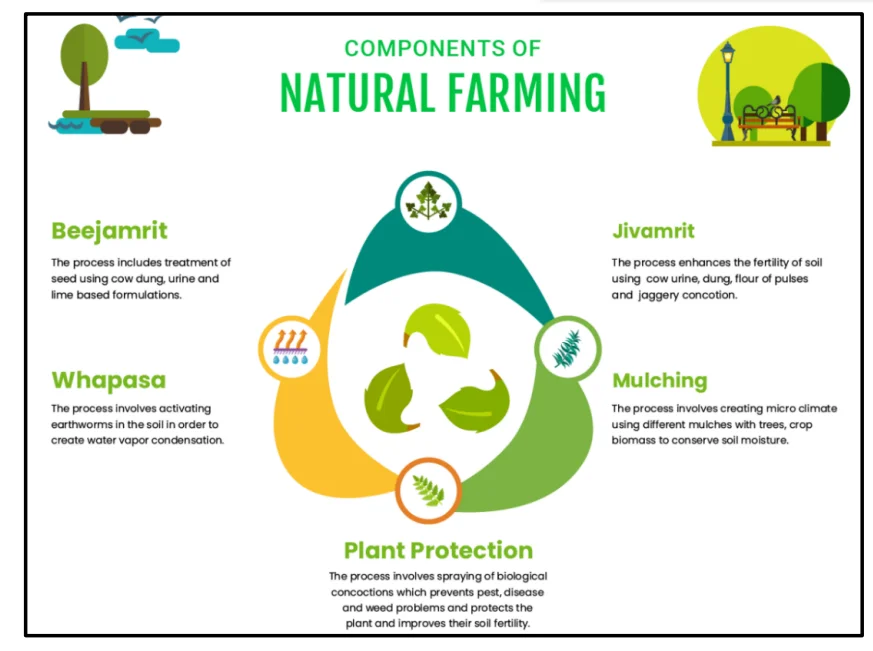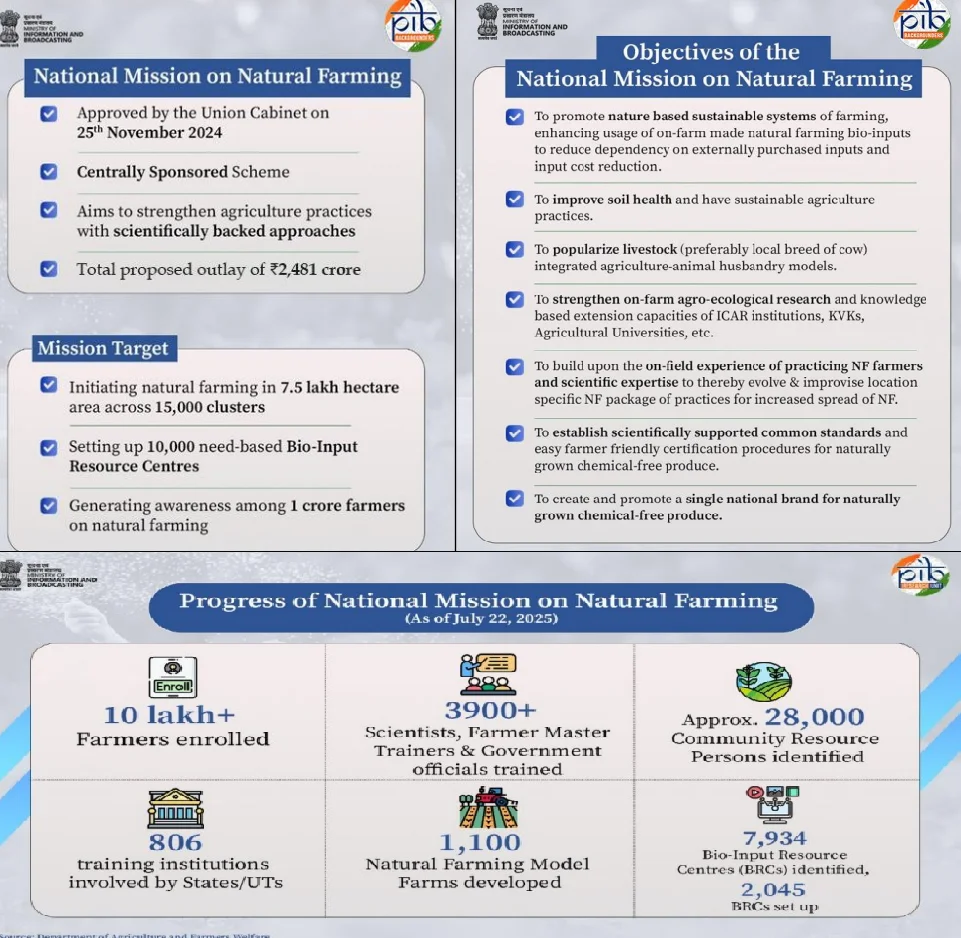Natural Farming in India | 14 Oct 2025
For Prelims: Natural farming, Zero budget natural farming, Bhartiya Prakritik Krishi Paddhati, SDG 12 (Sustainable Consumption and Production)
For Mains: Principles, practices, and benefits of natural/chemical-free farming, Challenges in mainstreaming natural farming in India.
Why in News?
Himachal Pradesh is witnessing a major shift as thousands of farmers move away from chemical-based agriculture toward natural farming. This transition reflects India’s wider push for sustainable and eco-friendly agriculture.
What is Natural Farming?
- Definition: As per NITI Aayog, Natural Farming is “a chemical-free traditional farming method” rooted in agroecological principles integrating crops, trees, livestock, and functional biodiversity.
- It follows the philosophy of working with nature, emphasizing minimal human intervention (often referred to as “do-nothing farming”) and the complete avoidance of synthetic chemicals.
- Key Features and Principles:
- No External Chemical Inputs: Completely avoids chemical fertilizers, pesticides, herbicides, and growth regulators.
- On-farm Input Generation: It relies on agricultural inputs such as Neemastra, Agniastra, Jeevamrit, and Beejamrit, which are locally prepared on farms using materials like cow dung, cow urine, jaggery, gram flour, and soil.
- Livestock Integration: Native cow breeds are central for sourcing inputs and maintaining the nutrient cycle.
- Diversified Cropping System: Encourages intercropping, mixed cropping, agroforestry, and crop rotation.
- Soil Health and Biodiversity: Emphasizes mulching, cover cropping, and maintaining microbial activity for fertile and living soil.
- Water efficiency: Uses minimal irrigation and improves soil moisture retention naturally.
- Scientific and Environmental Benefits: Enhances soil organic carbon and soil fertility, reducing the need for synthetic inputs.
- Promotes biodiversity, including beneficial insects, pollinators, and soil organisms.
- Reduces greenhouse gas emissions by avoiding urea and other nitrogenous fertilizers.
- Improves climate resilience of farms, especially under drought and erratic rainfall conditions.
How is Natural Farming Benefiting Farmers and Rural Livelihoods in India?
- Reduced Cost of Cultivation: Natural farming is not just an ecological alternative but also offers tangible socio-economic benefits to Indian farmers. The Zero budget natural farming (ZBNF) is the most popular model in India.
- The cost of inputs under natural farming is 50–60% lower than conventional chemical farming.
- Farmers significantly save on input costs since bio-inputs are prepared on-farm using locally available resources.
- Improved Farmer Incomes: Though initial yields may be stable or slightly reduced, long-term productivity is sustained or increased due to improved soil health.
- Income stability is achieved through intercropping, value-added products, and reduced crop failure risk.
- Employment Generation: Encourages local entrepreneurship in bio-input production, seed banks, composting, and local market chains. Promotes rural youth participation by making agriculture more knowledge-based and sustainable.
- Health and Food Security: Natural produce is free from harmful pesticide residues, ensuring better nutrition and food safety.
- Enhances nutritional density of food, addressing concerns of hidden hunger and health disorders due to chemicals.
- Women Empowerment: Involves women in preparation of bio-inputs, composting, kitchen gardening, and farmer producer groups.
What are India’s Initiatives for Natural Farming?
- National Mission on Natural Farming (NMNF): A centrally sponsored scheme by the Ministry of Agriculture & Farmers Welfare, promoting chemical-free, ecosystem-based natural farming rooted in traditional knowledge.
- The NMNF targets 7.5 lakh hectares across 15,000 clusters and aims to facilitate 1 crore farmers.
- An incentive of Rs 4,000 per acre per year for two years is being provided to encourage adoption of natural farming practices.
- NMNF builds on the earlier Bhartiya Prakritik Krishi Paddhati (BPKP) under the Paramparagat Krishi Vikas Yojana (PKVY).
- Bhartiya Prakritik Krishi Paddhati (BPKP): As of March 2025 it supports 28 lakh farmers practicing natural farming on 9.4 lakh hectares.
- State-Level Initiatives:
What are the Key Challenges in Mainstreaming Natural Farming Across India?
- Knowledge and Skill Gaps: Natural farming is knowledge-intensive and site-specific, requiring farmers to understand ecological interactions and adopt new practices.
- Many farmers, especially in remote areas, lack practical understanding and require continuous handholding by Krishi Sakhis.
- Behavioural Resistance: Farmers accustomed to high-input, chemical-intensive practices often hesitate to shift to low-input, labour-intensive natural farming.
- State-Level Variability: Successful models exist in Himachal Pradesh, Andhra Pradesh, Gujarat, etc., but soil, climate, and social conditions vary, making uniform replication challenging.
- Policy Convergence Complexity: Coordinating NMNF with other central/state schemes (livestock, rural development, AYUSH, food processing) and local institutions is administratively challenging.
- Market Linkages and Premium Pricing: Establishing reliable markets for chemical-free produce remains a challenge.
- Farmers may hesitate to switch if premium pricing and assured minimum support price (MSP) are not consistently available.
- Input Availability and Infrastructure: Ensuring timely availability of bio-inputs across all regions, especially remote areas, requires robust Bio-input Resource Centres (BRCs) and supply chains.
What Measures can be Adopted to Scale Natural Farming in India?
- Decentralized Farmer Clusters: Form contiguous natural farming clusters to enable peer learning, reduce input costs, and facilitate community-level extension support.
- Strengthen Knowledge Networks: Deploy Krishi Sakhis, Community Resource Persons, and KVKs to provide hands-on training in NF techniques, bio-input preparation, pest management, and multi-cropping.
- Bio-input Accessibility: Establish local Bio-input Resource Centres (BRCs) and promote on-farm production of organic inputs to reduce dependency on external chemical inputs.
- Market Integration and Certification: Develop PGS/organic certification, promote a national brand for NF produce, and strengthen linkages with Agricultural Produce Market Committees (APMCs), Farmer Producer Organizations (FPOs), and local markets to ensure fair pricing.
- Agro-ecology Based Research: Tailor region-specific NF cropping systems and soil-moisture management practices to enhance resilience in varied agro-climatic zones.
- Digital Monitoring and Knowledge Sharing: Use geo-tagged tracking, online portals, and mobile advisory services to monitor adoption, yields, and ecological outcomes while providing timely guidance.
Conclusion
Natural farming promotes nutrient-rich, chemical-free food while reducing input costs for farmers. It aligns with India’s broader sustainability goals, supporting SDG 2 (Zero Hunger) by improving food security, and SDG 12 (Sustainable Consumption and Production) by encouraging eco-friendly agricultural practices.
|
Drishti Mains Question: Examine the role of natural farming in promoting sustainable agriculture and improving farmer livelihoods in India. |
Frequently Asked Questions (FAQs)
1. What is Natural Farming?
Natural Farming is a chemical-free, traditional farming system integrating crops, livestock, and biodiversity to enhance soil health and ecological balance.
2. What is the National Mission on Natural Farming (NMNF)?
NMNF is a centrally sponsored scheme launched in 2024 to promote chemical-free, ecosystem-based natural farming, covering 7.5 lakh hectares and supporting 1 crore farmers.
3. Which bio-inputs are commonly used in Natural Farming?
Locally prepared inputs like Beejamrut, Jeevamrit, Neemastra, and Agniastra are used, made from cow dung, cow urine, jaggery, gram flour, and soil.
UPSC Civil Services Examination, Previous Year Question (PYQ)
Prelims
Q. How is permaculture farming different from conventional chemical farming? (2021)
- Permaculture farming discourages monocultural practices but in conventional chemical farming, monoculture practices are predominant.
- Conventional chemical farming can cause an increase in soil salinity but the occurrence of such phenomenon is not observed in permaculture farming.
- Conventional chemical farming is easily possible in semi-arid regions but permaculture farming is not so easily possible in such regions.
- Practice of mulching is very important in permaculture farming but not necessarily so in conventional chemical farming.
Select the correct answer using the code given below.
(a) 1 and 3
(b) 1, 2 and 4
(c) 4 only
(d) 2 and 3
Ans: (b)
Q. Consider the following agricultural practices: (2012)
- Contour bunding
- Relay cropping
- Zero tillage
In the context of global climate change, which of the above helps/help in carbon sequestration/storage in the soil?
(a) 1 and 2 only
(b) 3 only
(c) 1, 2 and 3
(d) None of them
Ans: (b)



.webp)